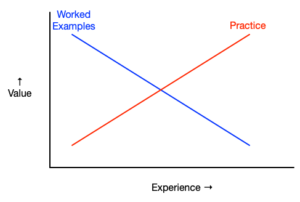 I’ve been going through several different forms of expert documentation. As a consequence, I’ve been experiencing a lot of the problems with that! Experts have trouble articulating their thinking. This requires some extra work on the part of those who work with them, whether instructional designers, technical writers, editors, whoever. There are some reliable problems with experts and explanations that are worth reviewing.
I’ve been going through several different forms of expert documentation. As a consequence, I’ve been experiencing a lot of the problems with that! Experts have trouble articulating their thinking. This requires some extra work on the part of those who work with them, whether instructional designers, technical writers, editors, whoever. There are some reliable problems with experts and explanations that are worth reviewing.
The start of the problem is that the way we acquire expertise is to take our conscious thinking and automatize it, basically. We want to make our thinking so automatic that we no longer have to consciously think about it. So, we basically compile it away. Which creates a problem. For one, what we process into memory may not bear a close resemblance to what we have heard and applied. That is, the semantic language we use to guide our practice and internalize may not be what we store as we automate it.
It’s also the case that we lose access to that compiled away expertise. There’s evidence of this, for one from the results of research by the Cognitive Technology group at the University of Southern California showing experts can’t access about 70% of what they do! Another piece of evidence is the widespread failure of so-called ‘expert systems’ in the 80s, resulting in the AI winter. Whether the locus of the problem is in what actually gets stored, or access to it, the result is that what we were told to do, and say we do, may not actually be close to what we actually do.
Another problem is that experts also lose touch with what they grappled with as novices. What they take for granted isn’t even on the radar of novices. So it’s difficult to get them to provide good support for acquiring skills or understanding. Their attempts at explanations for reference of instruction fail.
All told, this leads to systematic gaps in content. I’ve been seeing this manifest in explanations that may say what to do, but not why or how. There may be a lack of examples, and the thinking behind the examples I do see isn’t there. There’s also a lack of visual support. They’re not including diagrams when it’s conceptual relationships that need understanding. They’re also not including images when context is needed. They shouldn’t necessarily be blamed, because they don’t need the support and can’t even imagine that others do!
It’s clear that experts should not be the ones doing the explanations. They’re experts, and they have valuable input, but there needs to be a process to avoid these problems. We need tech writers, IDs, and others to work with experts to get this right. Too often we see experts being tasked with doing the explanations, and we live with the consequences.
What to do? One step is to let experts know that their expertise is in their domain, but the expertise in extracting that expertise and presenting it lies in others. To do so convincingly, you’ll need the science about why. For another, know techniques to unearth that underlying thinking. Also allow time in your schedule for this to happen. Don’t think the SME can just give you information; you’ll have to process what you get to rearrange it into something useful. You may also need some sticks and carrots.
As I wrestle with the outputs of experts, here’s my plea. There are wonderful ways experts and explanations can work out, but don’t take it for granted. Don’t give experts the job of communicating to anyone but other experts, or to experts on working with experts to get explanations. Fair enough?






